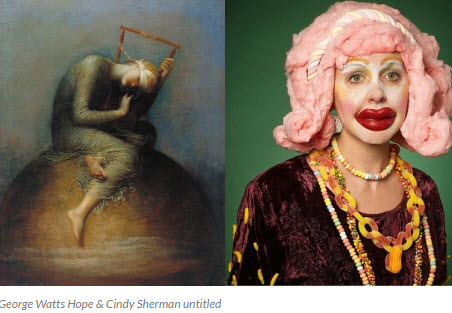
'What is love? What is creation? What is longing? What is a star?' thus asks the last man, and he blinks. -- Friedrich Nietzsche
When I was attending college for art I became rather dismayed by the development of art in the past century. I wondered how we got from beautiful meaningful art of the past to the banal silliness of postmodernism. At that time, a friend gave me a copy of Francis A. Schaeffer's Escape From Reason. Schaeffer's book offered a profound understanding of the development of culture. Schaeffer was concerned that Christians were unaware of the new environment which make it difficult to communicate the truth of scripture. He traced the development of philosophy to the arts and then to mass culture to show how it shaped the world-view of the 1960's. Although
Schaeffer was writing at the time of the emergence of postmodernism, things have changed drastically in the last 48 years, I'm certain that line of despair is hardly reflected in the current culture, rather, I find a self-consciousness culture which escapes through ironic detachment, instead of facing the conditions of alienation.
Schaeffer traced the influence of thought from Aquinas to the modern era, which I will not get into detail here, but what is important to understand is the impact of the enlightenment of the 18th century. The development of science created a "box" of reason, an assumption that the methods of science can in principle yield exhaustive knowledge of all reality. Schaeffer pointed out that "The early scientists believed in the uniformity of natural causes. What they did not believe in was the uniformity of natural cause in a closed system". The position of scientism is highly problematic, Albert Einstein said "All our science, measured against reality, is primitive and childlike," but unfortunately it is the foundation of the world-view of most people. We are lead to believe our amazing technology is from a thorough understanding of physics when in fact much of it was achieved by the trial and error of engineering. http://milesmathis.com/pi4.html
Below is Schaeffer's diagram which appears in Escape From Reason;it is divided into two levels with the subjects of transcendental truth on the upper level, the modern disciplines that are limited to a closed system are on the lower, the result is rather totalitarian. Everything that gives life meaning: God, love, morals, freedom, and significance appear to have been stamped out by an Orwellian boot. Mysticism, indefinable truth that was accepted since ancient times was rejected as irrational. The modern disciplines only regard subjects that can be defined to be worthy of academic discourse.

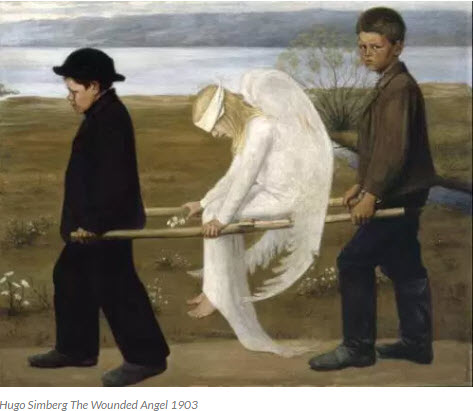
Schaeffer claimed that line of despair began with the philosopher Kierkegaard, which "arose from the abandonment of a hope of a unified answer for knowledge and life". But I doubt that few were ever conscious of this, rather I would say the despair came from a sense of the tension of humanity being placed in a box after the "death of God". It's important to understand that Friedrich Nietzsche's claim spoke of the death of faith in God,” I shall tell you. We have killed him--you and I. All of us are his murderers. But how have we done this? Who gave us the sponge to wipe away the entire horizon? What did we do when we unchained this earth from its sun?" The expression of despair is prevalent in the work of the Symbolists of the late 19th century and the early 20th century. They sought to find meaning in the ruins of a decaying culture, their work reflects an interest in metaphor. Symbolism was in a way a reaction against Impressionism. While I tend to agree with Schaeffer, I hardly see the expression of despair as a tendency in art after the mid-20th century.
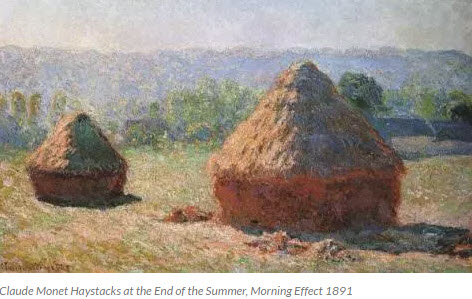
The line of stupidity developed due to the decline in metaphorical thought and the loss of the awareness of soul. It was mainly the Impressionists who opened the door to the line. In fairness, this was not intentional and much of their work is admirable. But their approach to art was void of poetry which lead to a breakdown of communication in culture. Jean Renoir, the son of the famous Impressionist wrote,” Pissarro and Monet were the fanatical of the whole crowd. They were the first to condemn the study of the great masters, and to advocate learning direct from nature, and from nature only". When Claude Monet (1840-1926) did a series of paintings of hay stacks, he was interested in the effect of light at different times of the day. In a sense, Monet's approach to nature was akin to a scientist's approach to nature, his painting was a recording of the "facts" of the effects of light. Obviously, Monet's paintings are more than scientific illustrations since his brush work and use of color reflect aesthetic interests. But his paintings lack an essential aspect of cultural objects in that the haystacks are not symbolic. A symbol is an image that signifies a concept which is outside of the visual perception of the physical object which it represents. So a symbolic tree is more than a picture of a large plant with a million leaves.
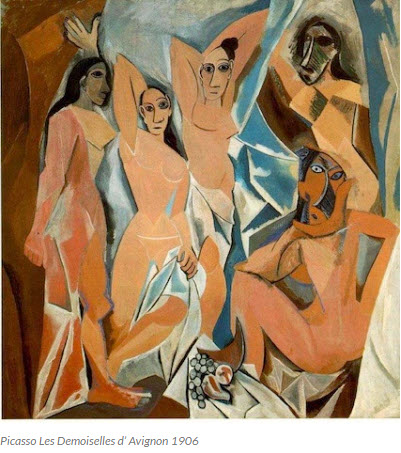 The Impressionists interest in light gave way to an interest in form. Pablo Picasso (1881-1973) was influenced by Cezanne's work to experiment with forms and textures from which he developed Cubism. Picasso’s Les Demoiselles d’ Avignon is often identified as the beginning of modern art and the subject of the painting is a scene in a brothel. Picasso represented a group of prostitutes with jagged forms, which can be read as an ascetic statement. Such a painting would have been unthinkable to the old masters, not only due to the technique of the painting but also due to the semantics of the work. Renaissance artists painted figures from Greek mythology to represent ideals, of course nobody worshipped Venus but the Renaissance artists painted Venus to symbolize the important concept of love and beauty. H.R.Rookmaaker recognized "[the Renaissance period] was a world in which it was possible to speak of the reality of such concepts as beauty or love. They were realities outside man, and man in his life and work had to reflect them, to realize them by working according to them. Love and beauty were not just man's feelings and subjective taste; they were really there: if he did not follow them, hate and ugliness would be the result." By the early 20th century, men began to perceive the world through the lens of positivism, recall how love was crossed out in Schaffer's diagram. Everything was to be defined rationally, therefore love and beauty were dismissed as an instinctual interest, so love was thought to only to be sex. Does Les Demoiselles d’ Avignon celebrate this view of humanity? Hardly, the painting reflects an embarrassment for the goats and monkeys.
The Impressionists interest in light gave way to an interest in form. Pablo Picasso (1881-1973) was influenced by Cezanne's work to experiment with forms and textures from which he developed Cubism. Picasso’s Les Demoiselles d’ Avignon is often identified as the beginning of modern art and the subject of the painting is a scene in a brothel. Picasso represented a group of prostitutes with jagged forms, which can be read as an ascetic statement. Such a painting would have been unthinkable to the old masters, not only due to the technique of the painting but also due to the semantics of the work. Renaissance artists painted figures from Greek mythology to represent ideals, of course nobody worshipped Venus but the Renaissance artists painted Venus to symbolize the important concept of love and beauty. H.R.Rookmaaker recognized "[the Renaissance period] was a world in which it was possible to speak of the reality of such concepts as beauty or love. They were realities outside man, and man in his life and work had to reflect them, to realize them by working according to them. Love and beauty were not just man's feelings and subjective taste; they were really there: if he did not follow them, hate and ugliness would be the result." By the early 20th century, men began to perceive the world through the lens of positivism, recall how love was crossed out in Schaffer's diagram. Everything was to be defined rationally, therefore love and beauty were dismissed as an instinctual interest, so love was thought to only to be sex. Does Les Demoiselles d’ Avignon celebrate this view of humanity? Hardly, the painting reflects an embarrassment for the goats and monkeys.
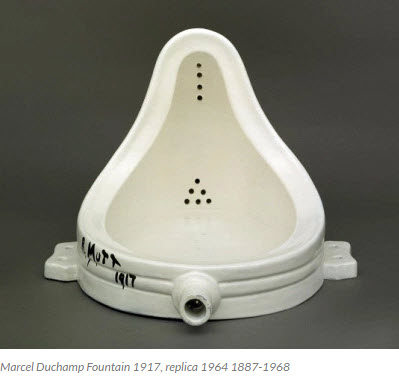
The line of stupidity collapsed into nihilism with the appearance of the anti-art movement Dada. At least Picasso and his followers still painted on canvases, but Dada rejected traditional aesthetics altogether. Schaeffer writes, "One such man was Marcel Duchamp (1887-1968), whom every Christian ought to know about. He could be called the high priest of destruction. He sought to destroy you from within yourself." His means of destruction were called "the bluff on nullity" Jean Baudrillard. Duchamp's ready-mades were manufactured objects that he had no hand in making but he exhibited them as "art". Many viewers approach his "works" like his urinal with the pretext that art should mean something, Duchamp made use of this uncertainty and presented the viewer with a null object, his work had the effect of alienating the viewer from the semantics of art. In effect he was saying "You dope, You think life and art are meaningful, when it's just a joke." Escape through irony is in any case itself an illusion, rather than challenge the "box" of utilitarian reason his work reflectedresignation before modern technocracy. Duchamp's work is only modern in terms of critical theory, but not in social political terms. The modern in social terms, recognizes the individual as a subject and is concerned with the concepts of freedom and rights. Duchamp's work actually stands in opposition to these concepts. Duchamp's act of removing himself from the creation of the work, was the act of denying his potential as a free creative subject. In writing a story or painting a picture, there are hundreds of decisions to be made, the writer and artist learns from this activity and grows. By exhibiting a urinal one will not know what one is capable of creating.
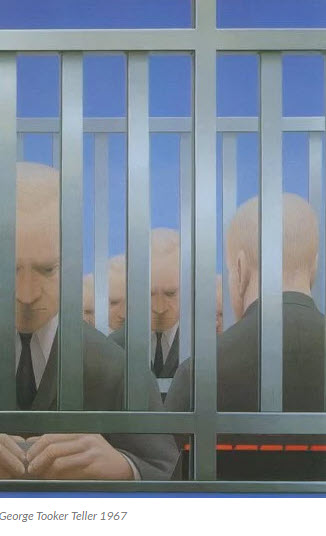
By the mid-20th century the expression of despair was more common of existential philosophers and writers than it was of artists but there are some exceptions. George Tooker (1920-2011) is known for his haunting paintings of contemporary men trapped in technological labyrinths. I had a chance to see an exhibit of his work at the PAFA several years ago. The great difference between his and the work of Duchamp is that Tooker acknowledged the state of alienation as serious problem but Duchamp's work reflects denial. Tooker became a Catholic later in his life while Duchamp's work is regarded today as a predecessor to postmodern. When my friend Michael Rizza was deciding on the topic of his Doctoral dissertation, we had a conversation about alienation. He brought up the fact that the phrase " an oxymoron like frozen fire because the postmodernists deny alienation. At least some of the modern artists realized there was something missing, that human beings are more than a biochemical machine, and often their work reflected a protest to the iron cage of technocracy. In contrast, postmodernism more often expresses a condition of passive stupidity.THE TOPOGRAPHICAL IMAGINATION OF JAMESON, BAUDRILLARD, AND FOUCAULT
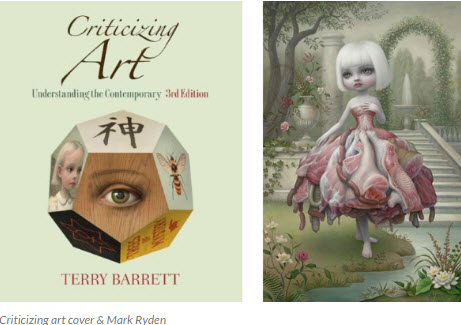
Mark Ryden is a preeminent contemporary artist, when I saw his work on the cover of a text-book of art criticism, it confirmed my thoughts that his work reflected the zeitgeist. It was the influence of the Impressionists indifference to symbolism which created a cultural vacuum, work like Ryden takes advantage of the vacuum. All of Ryden's paintings feature realistic yet cartoonish young girls in surreal parodies of Renaissance landscapes. To give one an idea of his work, the titles of some of his paintings include, A Dog Named Jesus, The Angel of Meat and Meat Dancer. When I saw the painting with the title Incarnation, I nearly hit the ceiling. Most of his painting include meat in some way, the young girl in Incarnation wears a meat dress. The Incarnation of Christ is a central to our faith that the Son of God became flesh, but in this painting is not blasphemous in that sense since there no reference to Christ. Instead the painting attacks one’s sense of soul. Referring to Schaeffer's diagram, not only is God crossed out but man is as well. Because everything limited to the perception of mechanics, human beings are regarded as a biochemical machine, therefore a soulless object. An interest in human beauty is assumed to be only an interest in sex. Ryden reflects this trousered apeview of humanity by painting young girls as objects with meat, it's a operation to cut joy out of the soul. What is worse, people are being affected by this culture, I'm sure Ryden is not working alone, his work appears to be Psy-ops against old pagan mysticism, I will not go into it here but it is something C.S. Lewis addressed in his writings.
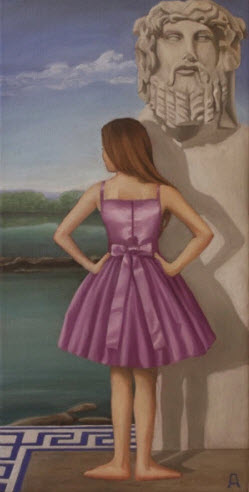
Nietzsche is mistaken as a predecessor to Postmodernism, it is clear in his writings he would have only contempt for the age, only contempt for the "despisers of the body". Nietzsche predicted that the loss of faith in God would result in an apathy for life. Reviewing the culture of postmodernism, his vision could not be more accurate. His metaphor of the last man predicted this condition, he imagined humanity as a herd blinking in the sun. His writing was actually therapy for a state of resignation that's why he envisioned the "over man" or "superman", but we don't we need Nietzsche's "superman" because humanity was created in God's image. Our existence is not transitory but eternal, this gives a deep assurance of the intrinsic significance and value of a human life. When contemporary artists desecrate the human form, in a sense, they are desecrating God Himself, for they have contempt for what God has made. Nietzsche envisioned the loss of love to create, he wrote, "Alas, the time is coming when man will no longer give birth to a dancing star. Alas, the time of the most despicable man is coming, he that is no longer able despise himself. Behold, I show you the last man."
When I give birth to a dancing star it not surprising if no one notices.

